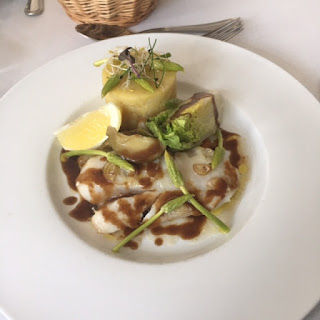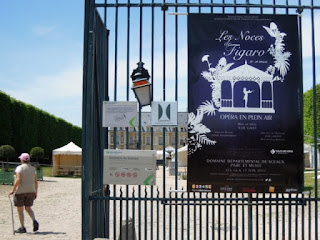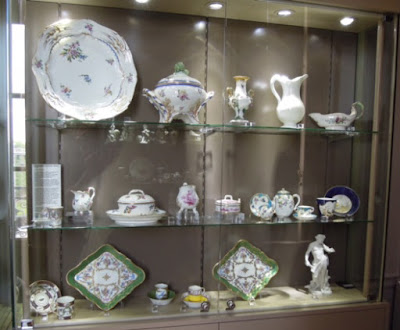 |
| Voltaire’s “Smile of Reason” |
By Moristotle
The day we went back to Le Parc de Sceaux (June 15), we first went grocery shopping at Monoprix. We arrived at Monoprix a few minutes before it opened (at 9:00), which gave us a chance to observe that for at least some of the staff, opening time was also their time to report to work – perhaps, for them, more their time to start than customers’ time to expect to begin to be served!
For, at about ten minutes after Monoprix opened, after getting everything on our list but some deli items, I asked a woman who was stocking shelves near the deli when the deli would open. She said, “En dix [10] minutes!” But in 15 minutes, the deli still showed no sign of opening. We decided to purchase what we had and forget any deli items.
 |
| Monoprix was open but not quite ready to start |
He said, “Life is a mirror: you smile, it smiles back at you.”
Carolyn asked him whether he had lived here his whole life. “Fifty years,” he said. “I don’t know where I’ll live the next fifty.”
He asked where we were from. “You will live here now?” he asked. “Until the end of June,” I said. “Why not forever?” he asked.
Carolyn said, “It’s not possible.”
“Why not?” he asked. “You say ‘Yes,’ it’s possible!”
I said, “You have an advanced philosophy. Did you develop it from reading good books, or from experience?”
With a beatific smile he said, “Perhaps both.”
I remembered this conversation yesterday, when I was starting to read the book our friend Penelope Griffiths would lend me less than a week later, when we visited her in Cardiff (the subject of a future entry in the Paris Journal).
Her copy of Personal Best, by Paralympic Games champion swimmer Marc Woods, is autographed; she was given it at a motivational assembly hosted by the pharmaceutical company she currently works for, at which Mr. Woods roused the troops. Doesn’t what he says in Chapter 1, “Living proactively,” sound like the philosophy of the man at the bus stop?:
Once you have decided to [live life proactively], you must commit to being the best you can be at that very moment in time. Not tomorrow, next week, or next year, but right here and now.It’s fun to think that if Carolyn and I took the advice of the man at the bus stop and said “Yes” to living in Paris forever, we might realize the promise on the cover of Marc Wood’s book, and “achieve our full potential.” What better place to do that than Paris!
Anyway, we were about to go to the park at Sceaux, which we could reach by taking an RER train from Gare du Nord – about half an hour south of the station. (“RER” stands for Réseau Express Régional, or Regional Express Network.)
We arrived at the Bourg-la-Reine stop at precisely 11:30, but it took us only fifteen minutes to become thoroughly confused where to catch a bus to the Château de Sceaux, which was very close to the restaurant where Carolyn had made reservations for us to have lunch at 1 o’clock: Le Trévise. It was looking as though we didn’t have enough time before 1:00 to visit the Château beforehand, so maybe we should try to have lunch first.
We decided to walk – the route looked straightforward enough – and I consulted the Compass app on my iPhone a couple of times to make sure we were going in the direction shown by the RATP app (Régie Autonome des Transports Parisiens, or Autonomous Operator of Parisian Transports; we didn’t always have wifi, so I had made a screen shot of RATP’s map for today’s journey).
Compass or not, we took a slightly wrong turn toward the Château (walking along the Allée d’Honneur rather than past the Lycée Lakanal, as specified by the map) and ended up across a wide street from the restaurant, but without realizing that we were there! Going by the map, I thought we needed to walk southward a bit to reach it, but after a few minutes, I saw that the numbers were wrong, and getting higher rather than approaching the address, at 8 Avenue Claude Perrault. Were we on the wrong street? I ran back to check, and in the process asked a local which way was Le Trévise. She pointed to the restaurant, about 50 meters across the way. Voilà!
It was almost an hour before our reserved time, so I asked whether we could be seated now. “Yes!” It was uncomfortably hot, so I asked whether we could sit inside. “Follow me,” and the waiter (or maître d’? – it appeared to be a very fine restaurant – led us into a deserted restaurant.
It was very fine indeed, and the food was excellent. We both wanted Gambas Royale (Royal Giant Prawns), but they were prepared to present only one prawn, so I had cod. Delicious!
 |
| Some sort of palette-cleansing starter; Carolyn didn’t like it, so I got to have hers too! |
(I included additional photos from Le Trévise in July 21’s post, “Bon appétit!”)
Well-lunched, we entered Le Parc de Sceaux. We had come especially to visit the museum in its Château de Sceaux, which we had found closed in April last year.
It was about 1:30 when we reached the entrance to the Château de Sceaux’s museum, only to discover that it wouldn’t open until 2:00! So...we sat in a breezy shade and had little boxes of Häagen-Dazs ice cream at a nearby outdoor concession stand, where a shy but friendly Chihuahua tentatively befriended us.
Two o’clock arrived, and we went to the entrance of the château, from which we saw once again the grand vista we had enjoyed last year:
 |
| 2016 photo (April 25) |
The museum was informative, but neither of us now thought it was worth our having returned so as not to miss visiting it again. We stayed for only about 50 minutes. The museum’s focus seems to be to preserve the history, artifacts, and portraits of aristocrats and their cháteaux & parks in the Paris area.
There was a model of another such estate in the Paris region:
One historical figure, Jean François Hippolyte Lecomte, who obtained the Sceaux property in about 1798, apparently made his fortune in the American tobacco trade (a haut-bourgeois rather than an aristocrat?). Could the restaurant Le Trévise have been named after the family name of the man Lecomte’s daughter married (Napoléon Mortier de Trévise, son of Maréchal Mortier, duc de Trévise)? It hardly seem worth finding out.
Here’s an official description of the museum (which seems to be four-partite, of which we were aware of only one), from the ParisInfo website:
The Musée d’Ile-de-France opened in 1973 in the middle of the Domaine de Sceaux, and displays its collections in 4 prestigious settings. The Château du Second Empire displays the museum’s collections on the history of Paris from the 17th century to the middle of the 20th century. The Orangery, an art gallery built at the end of the 17th century by Jules Hardouin-Mansart, holds sculptures of the Jardins de l’Epoque by Colbert. The Aurore pavilion, a magnificent garden pavilion from the 17th century, has a cupola painted by Charles Le Brun with dawn as his inspiration. Lastly, the renovated Ecuries de Colbert offers several services: a restaurant, shop, multimedia area and temporary exhibition room. Round off your visit with a stroll around the gardens designed by Le Nôtre.Two huge vases, looking identical, occupied corners of the museum entry (& exit) space:
 |
| The vase on the right (exit/entrance is to the left of it) |
Walking past the main entrance of Le Trevise, which we hadn’t seen earlier, afforded me the opportunity to photograph it:
At the nearest [192] bus stop, along the street we SHOULD have come by, we met a man who engaged us in conversation. My French seemed to come back better than usual, and I tried to say it had been 55 years since I’d studied (I won’t say learned) French, in college. At this point he volunteered that he was 93 years old (although I at first misinterpreted “quatre-vignte-treize” as “quat-vignte-trois” – 83 – and had been corrected, by a man who knew the value of those additional ten years!). He said he had flown military airplanes in 1946 (at age 22). He had been a squadron leader. I saluted him at this, but he seemed to guffaw at it – had I embarrassed him, had I taken a liberty not permitted a civilian? Indeed, he didn’t say much after that; he even seemed to turn away. At any rate, we had no further conversation with him.
We had been waiting at the bus stop for about 20 minutes when a 192 bus approached, and I waved it down for some reason – perhaps just because I was so glad to see it. We were used to the next bus (or metro)’s showing up in two or three, or no more than five minutes. But the bus rushed by without stopping!
Carolyn and I didn’t waste any time, but immediately started walking back to the train station, arriving in about 15 minutes and boarding the train in another five. Waiting’s only reward had been another memorable conversation. Unless you count the additional exercise.
On the way from the metro to the apartment, we stopped at Le Boulangerie des Deux Frères and Carolyn purchased two slices of pizza.
From the apartment, I went back, with a grocery bag, to Panier Lamarck for some fruits and vegetables.
After dinner, we sat down to watch a couple of the remaining four (of 21) episodes of Designated Survivor. Of course, we watched all four!
And I stayed up even longer, to prepare a family email (from which most of the material above was taken). It was 11:30 p.m. when I finished. The final sentence of my email was: “Thank goodness that I am sleeping so much better in Paris than in Mebane.”
| Copyright © 2017 by Moristotle |

















Most of the Chateaus around where I lived in France was in bad shape and uninhabitable. In the sixties when I was there France was still recovering from WWll. I meant to ask you, do they still the urinals along the sidewalks in Paris. They were build mainly for men and you walked in and pissed in a trough that had a tube which ran down to the gutter along the street. The metal walls reached to your shoulders and you could watch the people walk by as you did your business. There was a sign that said you could not stay in there for mode than ten minutes---wonder why?
ReplyDeleteThe “pissoirs” have gone, thankfully. But I too remember their being pointed out to me by my friend Jim Rubin that December in 1965 that I described in “Sightings.” Ever since, “pissoir” has been one of my favorite words. There’s such panache in its very sound.
DeleteEd, Carolyn reminded me that we passed a round structure on the corner across the street from this fabulous multi-storied fabric store, St. Peter's Market, a couple of hundred meters southwest down from Sacre-Coeur. Was that, possibly, a pissoir?
DeleteApparently not. From Wikipedia's entry on "Pissoir": "At the peak of their spread in the 1930s there were 1,230 pissoirs in Paris, but by 1966 their number had decreased to 329. By 2006 only one remained, on Boulevard Arago. (From 1981 they had been replaced systematically with new technology, the Sanisette.)"
Carolyn found an informative article about toilets in Paris: "Toilets In Paris – Before You Go You Should Know"; excerpt:
ReplyDeleteFor some travellers finding public toilets in Paris can be a traumatic experience, for one reason or another. You may be pleased to know that the city’s sanitation system has come a long way in the last ten years.